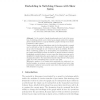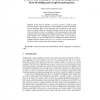GG
2004
Springer
14 years 6 months ago
2004
Springer
Model checking is increasingly popular for hardware and, more recently, software verification. In this paper we describe two different approaches to extend the benefits of model ...
GG
2004
Springer
14 years 6 months ago
2004
Springer
We show how edge-labelled graphs can be used to represent first-order logic formulae. This gives rise to recursively nested structures, in which each level of nesting corresponds ...
GG
2004
Springer
14 years 6 months ago
2004
Springer
Abstract. Graph programs as introduced by Habel and Plump [8] provide a simple yet computationally complete language for computing functions and relations on graphs. We extend this...
GG
2004
Springer
14 years 6 months ago
2004
Springer
Graphs are well-known, well-understood, and frequently used means to depict networks of related items. They are successfully used as the underlying mathematical concept in various ...
GG
2004
Springer
14 years 6 months ago
2004
Springer
Abstract. In the context of graph transformation we look at the operation of switching, which can be viewed as an elegant method for realizing global transformations of (group-labe...
GG
2004
Springer
14 years 6 months ago
2004
Springer
Refactorings are transformations that change the structure of a program, while preserving the behavior. The topic has attracted a lot of attention recently, since it is a promising...
GG
2004
Springer
14 years 6 months ago
2004
Springer
Abstract. Hierarchical graph transformation as defined in [1, 2] extends double-pushout graph transformation in the spirit of term rewriting: Graphs are provided with hierarchical...
GG
2004
Springer
14 years 6 months ago
2004
Springer
In this work we introduce event-driven grammars, a kind of graph grammars that are especially suited for visual modelling environments generated by meta-modelling. Rules in these g...
GG
2004
Springer
14 years 6 months ago
2004
Springer
We propose a faithful encoding of Java programs (written in a suitable fragment of the language) to Graph Transformation Systems. Every program is translated to a set of rules incl...
GG
2004
Springer
14 years 6 months ago
2004
Springer
Abstract. Development processes in engineering disciplines are inherently complex. Throughout the development process, different kinds of inter-dependent design documents are creat...



